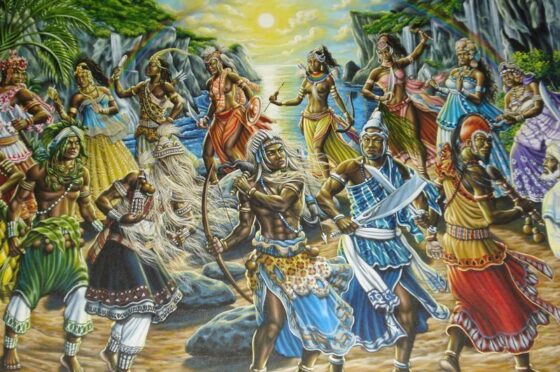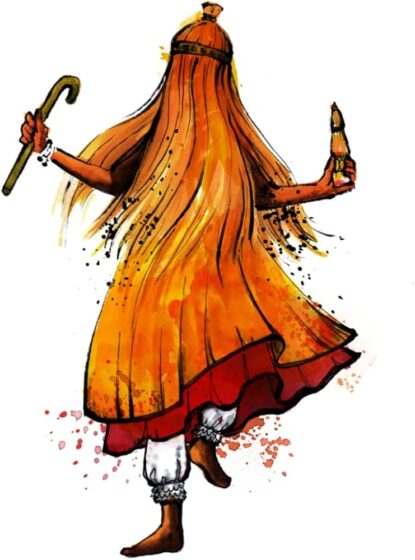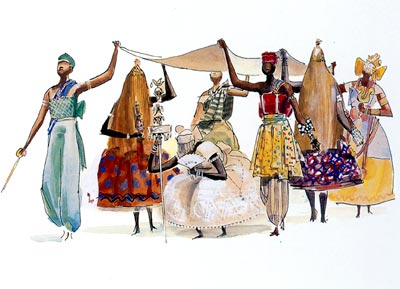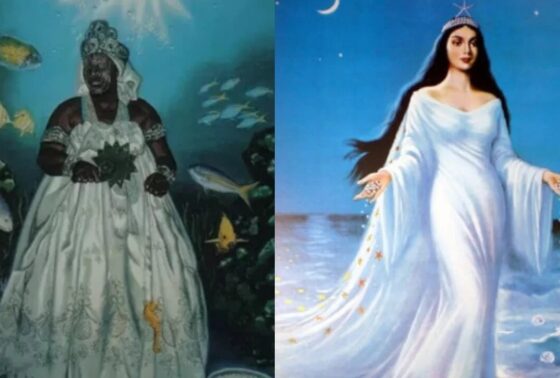By Linda Yudin
 The African ancestors of Brazil, the Yoruba of Nigeria and Benin, lived with a belief system that placed nature as the highest power, understanding the need to respect nature and honor the sacred bond between the natural elements and human beings. In Brazil, this system developed in the spiritual practice of Candomblé, where the orixás or deities are recognized as the divine energy of nature. In the city of Salvador, Bahia, the orixás are religious and cultural symbols that mark the rich African presence.
The African ancestors of Brazil, the Yoruba of Nigeria and Benin, lived with a belief system that placed nature as the highest power, understanding the need to respect nature and honor the sacred bond between the natural elements and human beings. In Brazil, this system developed in the spiritual practice of Candomblé, where the orixás or deities are recognized as the divine energy of nature. In the city of Salvador, Bahia, the orixás are religious and cultural symbols that mark the rich African presence.
These symbols can be found in both traditional and contemporary cultural life. Both the devotee who has gone through a rigorous process of initiation and the initiate look to this tradition for spiritual inspiration and for connection to the Cosmic World.
According to Yoruba peoples, after the world was created, each orixá received a divine energy called axé, giving the orixás the ability to govern certain aspects of the material world. Each orixá also represents different aspects of nature, both inside and outside the religious context. For example: Oxalá corresponds to the air we breathe and Oya/Iansã to the winds. Iemanjá is found in the oceans and seas; Oxum can be found in rivers and waterfalls; to contact Ochosi, the hunter; Ogun, the warrior; and Ossaim, who rules the sacred leaves, the clue is in the forests and to get close to Xangô, the god of thunder and lightning, one goes to a stone quarry as it is very dangerous to be close to a lightning rod.
In ORIXÁS by Pierre Verger, adopted son of Bahia and Candomblé authority, the author writes that the orixás are considered deified ancestors who, when alive, established control over certain forces of nature such as thunder, the wind, the fresh or salt waters, as well as specific activities such as hunting, metalworking, and knowledge of the qualities and use of plants.
After the death of this ancestor-orixá, his or her power could be transmitted momentarily to one of his descendants, or initiated devotees during the state of trance procession in the religious ceremony. When this possession takes place in the body of a devotee, a particular divine force or positive energy is passed on to the community called axé. (Pierre Verger 1981: 18)
The concept of axé is an affirmation of faith in the divine power of the universe as a place where human beings can derive strength and energy from the celestial world of the orixás. In the Candomblé philosophy , axé is also defined as the power to make things happen! It is the power to invoke, to create light, or a pathway of positive energy.
Symbolically expressed most profoundly in a religious context in the terreiro [temple] through ceremonial dances, gestures, rhythms, songs, clothing, colors and a systemized code of religious practice and behavior, the orixás create a spiritual link between orun-the heavens and alyé-the earth. As well as a geo-historical link between the rich influence of Africa and the Americas, where the orixás were recreated under the cruel conditions of slavery and the intolerance of the Catholic Church. Candomblé temples became the sacred space where the orixás found refuge to manifest the complexity of this spiritual system where the power of nature is so deeply respected. The following descriptions of their symbol and attributes include the most common and public knowledge about these orixas (Ligero 1993 and Omari 1984)
- Exu is the messenger god and responsible for all communication between the gods, ancestors and human beings. He has the ability to create calm and/or chaos, therefore, Exu is the first orixá to be offered his ceremonial food and drink in any ritual. Exu reveals himself to be the most human of all the orixás, neither completely good nor completely bad. He is responsible for the equilibrium of human beings. His colors are red and black and ceremonial greeting is “Laroye.”
 Ogum is the god of war, iron and technology, and has the ability to opens pathways. He is athletic, aggressive and fearless. Ogum dances in a war-like manner. His holy day is Tuesday. His colors are dark blue and green. His ceremonial greeting is “Ogunhé.”
Ogum is the god of war, iron and technology, and has the ability to opens pathways. He is athletic, aggressive and fearless. Ogum dances in a war-like manner. His holy day is Tuesday. His colors are dark blue and green. His ceremonial greeting is “Ogunhé.”- Omolu/Obaluaiye is the god of smallpox and epidemic diseases. He has the ability to create sickness and to cure. He dances bent over and very low to the ground, expressing pain and the trembling caused by fever. His day is Monday and his colors are black combined with red or white. He is the son of Nana Buruku and Oxumaré. His ceremonial greeting is “Toto.”
- Nanã Buruku is the mud and marshes. She is the oldest orixá linked with water and is the mother of death, whom she holds in the depths of the earth. She is the protector of secrets and responsible for forming the human body. She dances in a very dignified manner, demonstrating her old age and carries an ibiri rocking it like a baby, symbolizing her relationship with the deceased. Her colors are dark blue, lilac and white. Holy days are Monday and Saturday and ceremonial greeting is ”Saluba.”
- Oxumaré rules the rainbow and the serpent. He has a mysterious nature, and is intelligent and artistic. He is movement and activity. Traces the rainbow in his dance saluting both the heavens and the earth. His colors are yellow or green and black. Holy day is Tuesday and ceremonial greeting is “ArôMoboi.”
- Oxóssi rules the hunt, protects animals and lives in the forest. He protects those that live by hunting and does not tolerate those who unnecessarily kill. He dances as if he is aggressively hunting with his bow and arrow and his horsehair flywhisk. He is the king of the Ketu nation of Candomblé. His colors are light blue or green. Thursday is the day and his ceremonial greeting is “Okê Arô.”
- Logunede is considered to be the son of Oxum and Oxóssi. He lives 6 months with his father as a hunter and six months with his mother in the rivers as a fisherman. He dances with a bow and arrow and a mirror, representing movement characteristics of both parents. His colors are light blue and yellow, sacred day is thursday and ceremonial greeting is “Logun.”
- Ossaim is the god ruling the sacred force of leaves. He is a healer who knows all of the sacred powers of the leaves. He dances imitating the action of picking leaves from the trees and plants, collecting them in his pouch, and passing the leaves over the bodies of those in need of purification. His color is green, holy day is Saturday and his ceremonial greeting is “Ewe O.”
-
Xangô is the god of thunder, lightning, fire and justice. He is an outstanding dresser as evidenced in his rich ceremonial clothing and enjoys wearing decorative jewelry. His dance is very fast representing his regality, warrior-like nature, virility and connection to lightning. His colors are red and white, sacred day is Wednesday and his ceremonial greeting is “Kawo Kabiyesile.”
- Oyá/Iansã is the goddess of the winds and the storms. She is one of the most sensual, courageous and flirtatious of the female orixás. She is powerful, authoritarian and wages war with weapons in her hands. She dances stirring the air into wind, flirting and advancing into battle. Her colors are bright to earth red. She shares her sacred day, Wednesday, with Xango, and her ceremonial call is “Epa Hei, Iansã.”
- Oxum is the goddess of the rivers and beauty. It is said that she is as delicate as the flow of streams among the rocks, but also as powerful as the great waterfalls. Dances to a rhythm called ijexa, looking vainly into the mirror that she holds and grooming at her riverbank. Her colors are yellow/gold, sacred day is Saturday and ceremonial greeting is “Ore Yeyé O.”
- Obá rules the lagoon waters and is also a warrior. She is one of Xango’s wives and was concerned with pleasing him. Oxum, advised Obá to cut off her ear and use it as seasoning in Xango’s soup. Xango was not at all happy with this act and left Obá for Oxum. This is why Ob· dances covering her left. Other mythological stories depict Obá as an independent woman who was involved in commerce and politics. Her colors are red and white, sacred day is Saturday and ceremonial greeting is “Obá Xireê.”
- Ewá is said to be devoted and kind. Dances as if she is fighting, securing a harpoon in her left hand and a sword in her right. Her colors are red and yellow, holy day is Saturday and her ceremonial greeting is “RiRô.”
-
Iemanjá is the queen of the oceans and is the mother of all the orixás. Protects all fishermen and ensures them a safe return to her shores. She is calm and nurturing. On New Year’s Eve in Rio de Janeiro, her devotees ask for her blessings with gifts of white flowers at her shores. She dances mimicking the waves of her oceans. Her colors are translucent white and blue or green and ceremonial greeting is “Odê Iyé.”
- Oxalá is the father of all the orix·s; the white robed king and is the most important of all the orixás. He rules birth and creativity. Air is his nature’s element. It is said that he lives in a home in the celestial world. He manifests in two forms: Oxaguiã youthful and a warrior dancing in that manner and Oxalufã a wise elder who dances bent low to the ground like a very old man. Oxala’s color is white, his sacred day is Friday and hisis ceremonial greeting is “Ebá baba.”
The world of the orixá is vast and yet very accessible to look for ways in which to bring light and encouragement into one’s life. In the world of popular culture, Brazilian visual artists, dancers, and musicians, culinary artists have often found inspiration in this field. Afro-Brazilian dance vocabulary is based on the movements, gestures and stories of the orixás.
The orixá tradition informs society about spirituality, about African ancestry, about culture as well as provides a system in which to live one’s life by maintaining a relationship with nature’s elements and the world of the cosmos in order to confront the challenges of life on earth. In Brazil and throughout the Americas, the orix·s have become both cultural symbols and are respected for their sacred powers and profound knowledge. Axé!
* Linda Yudin is an ethnologist trained in dance and has spent the last three decades researching, presenting and teaching Afro-Brazilian dance and its cultural traditions. She is Co-Artistic Director of Viver Brasil Companhia de Dança – www.viverbrasil.com


















I lived for four years in Salvador, Brazil, and the influence of the Orixas was prevalent, especially in the arts, but actual information is not as easy to find if one is not fluent in Portuguese. Thanks for this primer to a vital heart of AfroBrazilian culture. For anyone visiting the city of Salvador, you will see Orixas everywhere if you know what you’re looking for.
The Yoruba were/ are not Brazil’s only African ancestors.
Hey mis perfumada
Dont be jelous
Be part of the spiritual world
Dont put limits dontput ur religion
On the top oh the list
Sarava! Oxala
Momento sancofa: Nossa fé atravessa fronteiras mesmo sem propagandas e construções “catedrasticas”…
https://soulbrasil.com/orixas-the-divine-forces-of-nature/
Pelamor de Deus, isso tudo é MUITO INCRÍVEL!!!